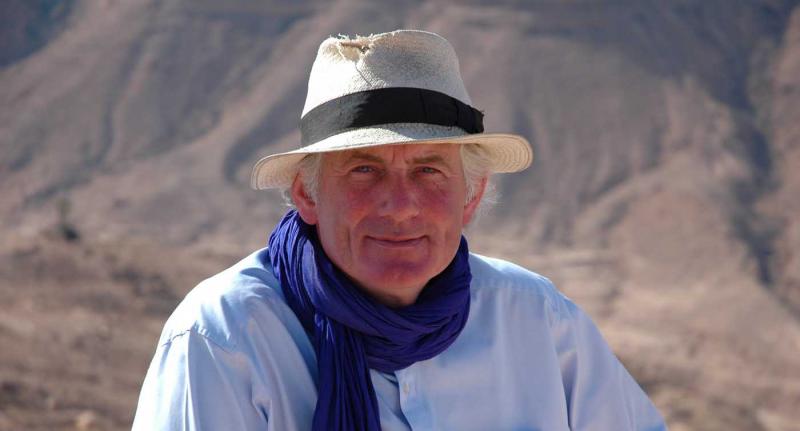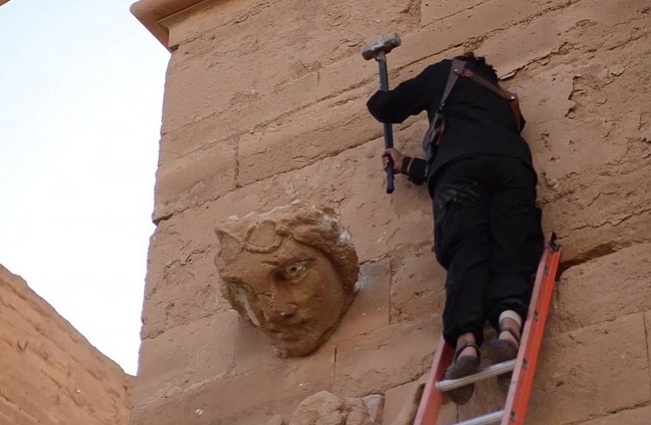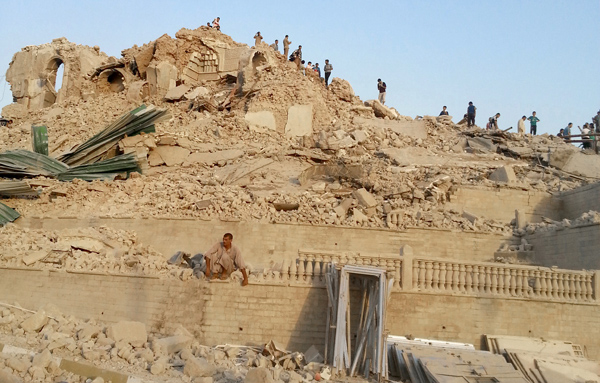Dan Cruickshank's Civilisation Under Attack, BBC Four | reviews, news & interviews
Dan Cruickshank's Civilisation Under Attack, BBC Four
Dan Cruickshank's Civilisation Under Attack, BBC Four
After destroying the historic artefacts, Islamic State will destroy the people. Are we planning to stop them?

This was one of the most disturbing, terrifying and informative programmes imaginable, made more so by Dan Cruickshank’s calm demeanour as he interrogated everyone from scholars to fanatics about the actions and rationale of the Islamic State (IS) during the past two years in Iraq and Syria. These conversations were set against his own visits to the Middle East and terrifying videos of IS hammering to smithereens the contents of museums and bulldozing world-famous archaeological sites.
When Cruickshank visited Iraq's ancient sites in 2002, he feared the destruction Western bombs might bring; little did he foresee that the cataclysm would come from within Iraq itself. And he clearly blames both the history of the boundaries imposed by France and Britain after the First World War, and ultimately the chaos unleashed in the aftermath of the Iraq war, which did not formally end until 2010 (culture vultures: IS on the warpath, pictured below).
 Cruickshank succinctly reminded us of the aims of IS, chiefly an ambition to create a worldwide Caliphate which pays no heed to national boundaries. No longer will Muslims be Syrians or Iraqis, but rather Sunni Muslims adhering to 7th-century Islam, a fundamentalist creed which can even extend to destroying Sunni sites such as Jonah's tomb in Mosul if they don't fit the framework imposed. There is a fearsome logic: the shared material culture, cultivated by Saddam Hussein as a way of reinforcing national identity, has to be obliterated, as any national identity must be subsumed to the IS version of Islam. As only Allah can be worshipped, anything that suggests another divinity must also be demolished.
Cruickshank succinctly reminded us of the aims of IS, chiefly an ambition to create a worldwide Caliphate which pays no heed to national boundaries. No longer will Muslims be Syrians or Iraqis, but rather Sunni Muslims adhering to 7th-century Islam, a fundamentalist creed which can even extend to destroying Sunni sites such as Jonah's tomb in Mosul if they don't fit the framework imposed. There is a fearsome logic: the shared material culture, cultivated by Saddam Hussein as a way of reinforcing national identity, has to be obliterated, as any national identity must be subsumed to the IS version of Islam. As only Allah can be worshipped, anything that suggests another divinity must also be demolished.
In an interview set improbably in an East End café specialising in delicious cakes, the notoriously provocative Muslim activist Anjem Choudary defended IS’s policy: God has no form, and anything from a non-Muslim past – or from the wrong kind of Islam – that does not adhere to IS’s Islam must go. Should Egypt fall to the Islamic State, then so will the pyramids. A world-weary Libyan archaelogist explained that all the museums of Libya are shut because of threats, and the treasures of the national museum have been boxed up and sent away.
Mesopotamia, the crossroads of the world, set between two rivers, was the home of the first written language, of the invention of the wheel, and above all perhaps the creation of cities, the very meaning of civilisation. Cruickshank’s own early 21st-century travels showed us some of Iraq’s great sites, including Hatra, a great city now in ruins (IS art-assassin at work in Hatra, pictured below).
 One of the most lucid commentators was Matthew Bogdanos, now an assistant attorney general in New York. He's also a classicist who, while a US Marine Colonel in Iraq, investigated the looting of Baghdad’s National Museum, helped to recover thousands of objects and wrote a vivid history, Thieves of Baghdad. He put several aspects of the current situation under unrelenting focus; just as the Secretary General of UNESCO refered to debates and resolutions, Bogdanos reminded us that in this context words do not produce action. But are we prepared to use armed force to protect the cultural history of all humanity? Moreover, while first there are attacks aimed at destroying a cultural past, it's only as a preliminary to destroying actual people. That dilemma was put by an academic: how can we intervene to defend stones and statues, if we are not prepared to intervene to prevent the slaughter of innocent men, women and children?
One of the most lucid commentators was Matthew Bogdanos, now an assistant attorney general in New York. He's also a classicist who, while a US Marine Colonel in Iraq, investigated the looting of Baghdad’s National Museum, helped to recover thousands of objects and wrote a vivid history, Thieves of Baghdad. He put several aspects of the current situation under unrelenting focus; just as the Secretary General of UNESCO refered to debates and resolutions, Bogdanos reminded us that in this context words do not produce action. But are we prepared to use armed force to protect the cultural history of all humanity? Moreover, while first there are attacks aimed at destroying a cultural past, it's only as a preliminary to destroying actual people. That dilemma was put by an academic: how can we intervene to defend stones and statues, if we are not prepared to intervene to prevent the slaughter of innocent men, women and children?
This deeply compelling programme raised many more questions than it could possibly answer, and in showing us IS promotional videos, also showed us many contradictions. If displaying the human form is forbidden, how does IS reconcile the showing of its contemporary fighters? IS has mastered the latest technological media, a profound irony as the world hailed the positive power of twitter during the Arab Spring. Moreover IS controls 4,500 archaeological sites in Syria, and aerial views show us how they are already being looted in order to finance IS: the more IS bulldozes, the greater the monetary value of what remains. IS is exploiting the ultimate cash cow, presumably with the connivance of the art world – money always rules (ruins of Jonah's tomb, pictured below).
 We were reminded too that Damascus is the oldest continually occupied city in the world; what will be the fate of its Great Mosque? Palmyra (pictured above) is on a knife edge, its superb amphitheatre now the site for IS executions of Assad supporters. Hatra, 2,000 years old, and Nimrud, a 3,000-year-old Assyrian site in Iraq, are gone. What the 19th- and 20th-century archaeologists brought back to the museums of Paris, London and Berlin may be all that remains: Cruickshank duly enquired of a Louvre curator what security measures are in place.
We were reminded too that Damascus is the oldest continually occupied city in the world; what will be the fate of its Great Mosque? Palmyra (pictured above) is on a knife edge, its superb amphitheatre now the site for IS executions of Assad supporters. Hatra, 2,000 years old, and Nimrud, a 3,000-year-old Assyrian site in Iraq, are gone. What the 19th- and 20th-century archaeologists brought back to the museums of Paris, London and Berlin may be all that remains: Cruickshank duly enquired of a Louvre curator what security measures are in place.
But what solutions may there be? No one could suggest anything, except a longing for some kind of action amid a sense that nothing will work to stop IS's destruction of people, and the art that embodies millennia of human history. The last comment, by the historian Tom Holland, was simply to say that all that's left is hope.
Add comment
The future of Arts Journalism
You can stop theartsdesk.com closing!
We urgently need financing to survive. Our fundraising drive has thus far raised £49,000 but we need to reach £100,000 or we will be forced to close. Please contribute here: https://gofund.me/c3f6033d
And if you can forward this information to anyone who might assist, we’d be grateful.

Subscribe to theartsdesk.com
Thank you for continuing to read our work on theartsdesk.com. For unlimited access to every article in its entirety, including our archive of more than 15,000 pieces, we're asking for £5 per month or £40 per year. We feel it's a very good deal, and hope you do too.
To take a subscription now simply click here.
And if you're looking for that extra gift for a friend or family member, why not treat them to a theartsdesk.com gift subscription?
more TV
 In Flight, Channel 4 review - drugs, thugs and Bulgarian gangsters
Katherine Kelly's flight attendant is battling a sea of troubles
In Flight, Channel 4 review - drugs, thugs and Bulgarian gangsters
Katherine Kelly's flight attendant is battling a sea of troubles
 Alien: Earth, Disney+ review - was this interstellar journey really necessary?
Noah Hawley's lavish sci-fi series brings Ridley Scott's monster back home
Alien: Earth, Disney+ review - was this interstellar journey really necessary?
Noah Hawley's lavish sci-fi series brings Ridley Scott's monster back home
 The Count of Monte Cristo, U&Drama review - silly telly for the silly season
Umpteenth incarnation of the Alexandre Dumas novel is no better than it should be
The Count of Monte Cristo, U&Drama review - silly telly for the silly season
Umpteenth incarnation of the Alexandre Dumas novel is no better than it should be
 The Narrow Road to the Deep North, BBC One review - love, death and hell on the Burma railway
Richard Flanagan's prize-winning novel becomes a gruelling TV series
The Narrow Road to the Deep North, BBC One review - love, death and hell on the Burma railway
Richard Flanagan's prize-winning novel becomes a gruelling TV series
 The Waterfront, Netflix review - fish, drugs and rock'n'roll
Kevin Williamson's Carolinas crime saga makes addictive viewing
The Waterfront, Netflix review - fish, drugs and rock'n'roll
Kevin Williamson's Carolinas crime saga makes addictive viewing
 theartsdesk Q&A: writer and actor Mark Gatiss on 'Bookish'
The multi-talented performer ponders storytelling, crime and retiring to run a bookshop
theartsdesk Q&A: writer and actor Mark Gatiss on 'Bookish'
The multi-talented performer ponders storytelling, crime and retiring to run a bookshop
 Ballard, Prime Video review - there's something rotten in the LAPD
Persuasive dramatisation of Michael Connelly's female detective
Ballard, Prime Video review - there's something rotten in the LAPD
Persuasive dramatisation of Michael Connelly's female detective
 Bookish, U&Alibi review - sleuthing and skulduggery in a bomb-battered London
Mark Gatiss's crime drama mixes period atmosphere with crafty clues
Bookish, U&Alibi review - sleuthing and skulduggery in a bomb-battered London
Mark Gatiss's crime drama mixes period atmosphere with crafty clues
 Too Much, Netflix - a romcom that's oversexed, and over here
Lena Dunham's new series presents an England it's often hard to recognise
Too Much, Netflix - a romcom that's oversexed, and over here
Lena Dunham's new series presents an England it's often hard to recognise
 Insomnia, Channel 5 review - a chronicle of deaths foretold
Sarah Pinborough's psychological thriller is cluttered but compelling
Insomnia, Channel 5 review - a chronicle of deaths foretold
Sarah Pinborough's psychological thriller is cluttered but compelling
 Live Aid at 40: When Rock'n'Roll Took on the World, BBC Two review - how Bob Geldof led pop's battle against Ethiopian famine
When wackily-dressed pop stars banded together to give a little help to the helpless
Live Aid at 40: When Rock'n'Roll Took on the World, BBC Two review - how Bob Geldof led pop's battle against Ethiopian famine
When wackily-dressed pop stars banded together to give a little help to the helpless
 Hill, Sky Documentaries review - how Damon Hill battled his demons
Alex Holmes's film is both documentary and psychological portrait
Hill, Sky Documentaries review - how Damon Hill battled his demons
Alex Holmes's film is both documentary and psychological portrait

Comments
7th century Islam was never